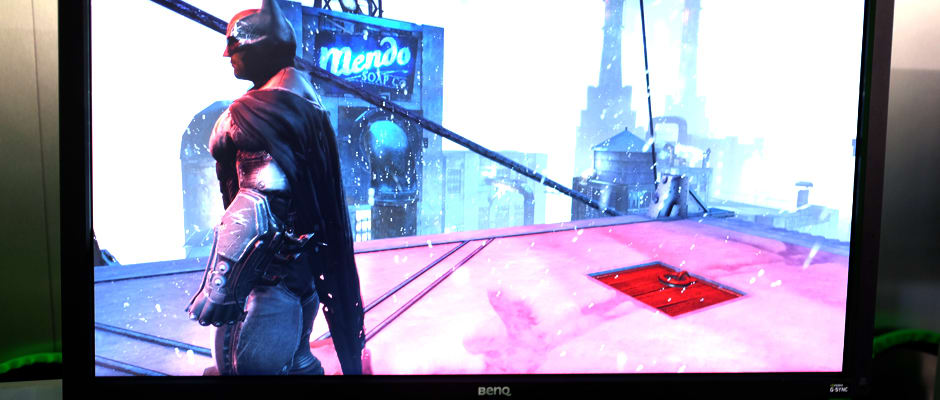{{brightcove '3037747780001'}}
How It Works
If you play a lot of games or just like to geek out over monitors, you've probably heard of "V-Sync."
For those of you who haven't, V-Sync—or Vertical Synchronization—is a setting found in computer games that syncs the game's FPS (frames per second) with your monitor's refresh rate.
This is done to eliminate an undesirable rendering effect known as "tearing." But since the game's frame rate needs to "wait" for each screen refresh, performance takes a hit.
With V-Sync the only available display synchronization option, gamers have traditionally had to choose between the best performance and the best picture.
NVIDIA's new "G-Sync" technology essentially does away with that conundrum.
G-Sync-capable monitors like the XL2720G, when paired with the right PC, can synchronize refresh rates with the computer's GPU (Graphics Processing Unit) at the hardware level. This process optimizes FPS performance without any degradation of picture quality—the best of both worlds.
The XL2720G is not the only monitor on the market to adopt NVIDIA's new technology, but BenQ is amongst only a handful of companies (ASUS, Philips, and ViewSonic are the others) with G-Sync capable monitors already.
Design Elements
More of a good thing
The XL2720G is more or less identical to BenQ's XL2420TE and XL2420T forebears. Matte black plastic with red highlights include useful features like a built-in headphone hook and cable organizer.
Like the rest of the XL series, the G model features a native resolution of 1,920 x 1080, a TN (Twisted Nematic) panel with a <5ms GTG refresh rate, built-in FPS and RTS modes, and a flexible stand that allows for changes in height, tilt, and orientation.
The XL2720G is listed within BenQ's new RevolutionEyes-equipped monitor lineup, which includes: ZeroFlicker technology (a variable lighting system to reduce eyestrain over long periods of monitor use), Black eQualizer (a shadow tone clarifier that increases visibility), and the newer Low Blue Light technology (which reduces the level of blue light within the monitor's luminous output).
Performance
G-Sync, a.k.a. 'BOUT TIME!
Obviously, as many neat features and gaming-centric details as it has, the XL2720G's greatest feat is functioning properly with NVIDIA's G-Sync technology. We played Batman: Arkham Origins at NVIDIA's demo booth on the XL2720G, where we were able to toggle the game with V-Sync, without V-Sync, and with G-Sync.
Take it from us: You don't need to be a seasoned gamer to appreciate the difference.
G-Sync's contribution is probably most notable during horizontal panning scenes. With V-Sync enabled, the caped crusader's glide through the air was notably turbulent—the FPS counter dropped 5-10 frames (from about 60 to about 50) whenever Batman was moving within a complex 3D vector plane.
With V-Sync disabled, the frame rate was maintained, but—as we expected—picture quality was adversely affected. Batman's curve through tall buildings was met with tearing edges and reduced clarity.
With G-Sync, however, both the tearing and stuttering were eliminated. Personally, I forgot I was standing in the LVCC's South Hall; Batman did his gliding thing, and I watched the snowy scenery drift by in the same detail as if he were standing still. The FPS dipped only a couple frames—an imperceptible amount.
The bottom line is that G-Sync works, and the XL2720G is a terrific medium for it.
The monitor's only drawback lies in its niche nature: If you're not an avid or competitive gamer, there's not much reason to pursue this display. While pricing hasn't been announced, it's very likely the 27-inch, feature-stuffed XL2720G will retail for under $1,000. Expect BenQ's newest game-changer to grace the market by Q1 this year.
Meet the tester
Lee was Reviewed's point person for most television and home theater products from 2012 until early 2022. Lee received Level II certification in TV calibration from the Imaging Science Foundation in 2013. As Editor of the Home Theater vertical, Lee oversaw reviews of TVs, monitors, soundbars, and Bluetooth speakers. He also reviewed headphones, and has a background in music performance.
Checking our work.
Our team is here to help you buy the best stuff and love what you own. Our writers, editors, and experts obsess over the products we cover to make sure you're confident and satisfied. Have a different opinion about something we recommend? Email us and we'll compare notes.
Shoot us an email

